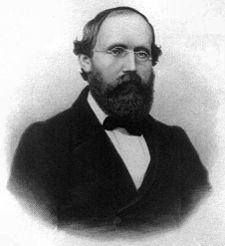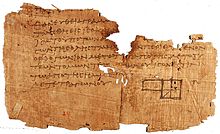
Bernhard Riemann
Did you know...
This wikipedia selection has been chosen by volunteers helping SOS Children from Wikipedia for this Wikipedia Selection for schools. Sponsoring children helps children in the developing world to learn too.
| Bernhard Riemann | |
|---|---|
 Bernhard Riemann, 1863 |
|
| Born | Georg Friedrich Bernhard Riemann September 17, 1826 Breselenz, Kingdom of Hanover (modern-day Germany) |
| Died | July 20, 1866 (aged 39) Selasca, Kingdom of Italy |
| Residence | Kingdom of Hanover |
| Nationality | German |
| Fields | Mathematics |
| Institutions | Georg-August University of Göttingen |
| Alma mater | Georg-August University of Göttingen Berlin University |
| Doctoral advisor | Carl Friedrich Gauss |
| Other academic advisors | Gotthold Eisenstein Moritz Abraham Stern Carl Wolfgang Benjamin Goldschmidt |
| Notable students | Gustav Roch |
| Known for | See list |
| Influences | Johann Peter Gustav Lejeune Dirichlet |
| Signature |
|
Georg Friedrich Bernhard Riemann [ˈʁiːman] (September 17, 1826 – July 20, 1866) was an influential German mathematician who made lasting contributions to analysis, number theory, and differential geometry, some of them enabling the later development of general relativity.
Biography
Early years
Riemann was born in Breselenz, a village near Dannenberg in the Kingdom of Hanover in what is the Federal Republic of Germany today. His father, Friedrich Bernhard Riemann, was a poor Lutheran pastor in Breselenz who fought in the Napoleonic Wars. His mother, Charlotte Ebell, died before her children had reached adulthood. Riemann was the second of six children, shy and suffering from numerous nervous breakdowns. Riemann exhibited exceptional mathematical skills, such as calculation abilities, from an early age but suffered from timidity and a fear of speaking in public.
Education
During 1840, Riemann went to Hanover to live with his grandmother and attend lyceum (middle school). After the death of his grandmother in 1842, he attended high school at the Johanneum Lüneburg. In high school, Riemann studied the Bible intensively, but he was often distracted by mathematics. His teachers were amazed by his adept ability to perform complicated mathematical operations, in which he often outstripped his instructor's knowledge. In 1846, at the age of 19, he started studying philology and theology in order to become a pastor and help with his family's finances.
During the spring of 1846, his father, after gathering enough money, sent Riemann to the renowned University of Göttingen, where he planned to study towards a degree in Theology. However, once there, he began studying mathematics under Carl Friedrich Gauss (specifically his lectures on the method of least squares). Gauss recommended that Riemann give up his theological work and enter the mathematical field; after getting his parents' approval, Riemann transferred to the University of Berlin in 1847. During his time of study, Jacobi, Dirichlet, Steiner, and Eisenstein were teaching. He stayed in Berlin for two years and returned to Göttingen in 1849.
Academia
Riemann held his first lectures in 1854, which founded the field of Riemannian geometry and thereby set the stage for Einstein's general theory of relativity. In 1857, there was an attempt to promote Riemann to extraordinary professor status at the University of Göttingen. Although this attempt failed, it did result in Riemann finally being granted a regular salary. In 1859, following Dirichlet's death, he was promoted to head the mathematics department at Göttingen. He was also the first to suggest using dimensions higher than merely three or four in order to describe physical reality—an idea that was ultimately vindicated with Einstein's contribution in the early 20th century. In 1862 he married Elise Koch and had a daughter.
Austro-Prussian War
Riemann fled Göttingen when the armies of Hanover and Prussia clashed there in 1866. He died of tuberculosis during his third journey to Italy in Selasca (now a hamlet of Verbania on Lake Maggiore) where he was buried in the cemetery in Biganzolo (Verbania). Meanwhile, in Göttingen his housekeeper tidied up some of the papers in his office, including much unpublished work. Riemann refused to publish incomplete work and some deep insights may have been lost forever.
Influence
Riemann's published works opened up research areas combining analysis with geometry. These would subsequently become major parts of the theories of Riemannian geometry, algebraic geometry, and complex manifold theory. The theory of Riemann surfaces was elaborated by Felix Klein and particularly Adolf Hurwitz. This area of mathematics is part of the foundation of topology, and is still being applied in novel ways to mathematical physics.
Riemann made major contributions to real analysis. He defined the Riemann integral by means of Riemann sums, developed a theory of trigonometric series that are not Fourier series—a first step in generalized function theory—and studied the Riemann–Liouville differintegral.
He made some famous contributions to modern analytic number theory. In a single short paper (the only one he published on the subject of number theory), he investigated the Riemann zeta function and established its importance for understanding the distribution of prime numbers. He made a series of conjectures about properties of the zeta function, one of which is the well-known Riemann hypothesis.
He applied the Dirichlet principle from variational calculus to great effect; this was later seen to be a powerful heuristic rather than a rigorous method. Its justification took at least a generation. His work on monodromy and the hypergeometric function in the complex domain made a great impression, and established a basic way of working with functions by consideration only of their singularities.
Riemann was the inspiration for mathematician Charles Lutwidge Dodgson (better known by his pen name Lewis Carroll) to write Alice's Adventures in Wonderland and Through the Looking-Glass.
Euclidean geometry versus Riemannian geometry
| Geometry |
|---|
 Oxyrhynchus papyrus (P.Oxy. I 29) showing fragment of Euclid's Elements
|
| History of geometry |
|
Branches
Euclidean geometry · Non-Euclidean geometry · Analytic geometry · Riemannian geometry · Differential geometry · Projective geometry· Algebraic geometry
|
|
Research areas
|
|
Important concepts
Point · Line · Perpendicular · Parallel · Line segment · Ray · Plane · Length · Area · Volume · Vertex · Angle · Congruence · Similarity · Polygon · Triangle · Altitude · Hypotenuse · Pythagorean theorem · Quadrilateral · Trapezoid · Kite · Parallelogram ( Rhomboid, Rectangle, Rhombus, Square) · Diagonal · Symmetry · Curve · Circle · Area of a disk · Circumference · Diameter · Cylinder · Sphere · Pyramid · Dimensions ( one, two, three, four)
|
|
Geometers
Aryabhata · Ahmes · Apolonius · Archimedes · Baudhayana · Bolyai · Brahmagupta · Euclid · Pythagoras · Khayyám · Descartes · Pascal · Euler · Gauss · Ibn al-Yasamin · Jyeṣṭhadeva · Kātyāyana · Lobachevsky · Manava · Minggatu · Riemann · Klein · Parameshvara · Poincaré · Sijzi · Hilbert · Minkowski · Cartan · Veblen · Sakabe Kōhan · Gromov · Atiyah · Virasena · Yang Hui · Yasuaki Aida · Zhang Heng
|
In 1853 Gauss asked his student Riemann to prepare a Habilitationsschrift on the foundations of geometry. Over many months, Riemann developed his theory of higher dimensions and delivered his lecture at Göttingen in 1854 entitled Über die Hypothesen welche der Geometrie zu Grunde liegen (" On the hypotheses which underlie geometry"). When it was finally published in 1868, two years after his death, the mathematical public received it with enthusiasm and it is now recognized as one of the most important works in geometry.
The subject founded by this work is Riemannian geometry. Riemann found the correct way to extend into n dimensions the differential geometry of surfaces, which Gauss himself proved in his theorema egregium. The fundamental object is called the Riemann curvature tensor. For the surface case, this can be reduced to a number (scalar), positive, negative or zero; the non-zero and constant cases being models of the known non-Euclidean geometries. I
Higher dimensions
Riemann's idea was to introduce a collection of numbers at every point in space (i.e., a tensor) which would describe how much it was bent or curved. Riemann found that in four spatial dimensions, one needs a collection of ten numbers at each point to describe the properties of a manifold, no matter how distorted it is. This is the famous construction central to his geometry, known now as a Riemannian metric.
Writings in English
- 1868 “On the hypotheses which lie at the foundation of geometry” translated by W.K.Clifford, Nature 8 1873 183- reprinted in Clifford's Collected Mathematical Papers, London 1882 (MacMillan); New York 1968 (Chelsea) http://www.emis.de/classics/Riemann/.
- 1868.“On the hypotheses which lie at the foundation of geometry” in Ewald, William B., ed., 1996. “From Kant to Hilbert: A Source Book in the Foundations of Mathematics”, 2 vols. Oxford Uni. Press: 652–61.
- Riemann, Bernhard (2004), Collected papers, Kendrick Press, Heber City, UT, ISBN 978-0-9740427-2-5, MR 2121437
